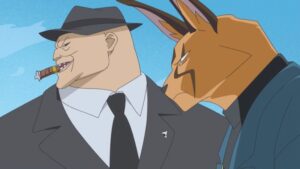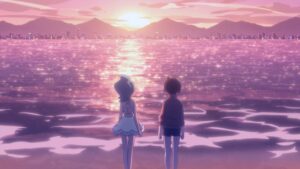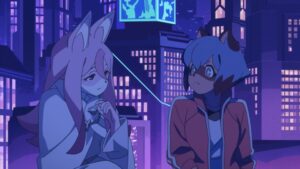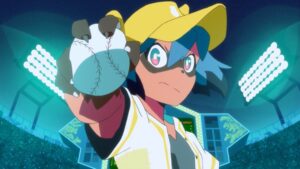It’s been nearly a week since Asenshi released episode 6 of BNA, but I’ve delayed in writing this post because I wasn’t sure how to approach it. If you’ve read the title, you know I’m dropping the series – but I wondered about my lead-in paragraph. Should I beat the dead horse-shaped argument of completing anime versus dropping it? Should I caution against studio worship, given that Trigger’s reputation caused many viewers (myself included) to set their expectations for the show too high? Or should I lay into the series for being a disappointment on its own terms, which would demand a more thorough breakdown of each episode?
As the week dragged on, I realized that it didn’t really matter what I led with. Most people won’t remember this show in three years, and they’ll certainly have forgotten my posts about it long before then. I haven’t enjoyed the series since its second episode, and I don’t want to watch it or talk about it anymore. This post just needs to be farted out so I can forget about BNA, and continue enjoying the few solid anime this virus-stricken spring season has to offer. So, in the spirit of abandonment, here are my brief thoughts about episodes 4-6.
“Dolphin Daydream” (episode 4)
After all Michiru’s angst about being trapped in her animal form, the way for her to regain her human body was… to focus on her desire to return to human civilization? Wasn’t she doing that for weeks prior to this episode? It’s been around a month since I’ve seen this one, but I can still remember pausing the video in frustration when she accidentally transformed at Nina’s house. I’ve only seen half the series, so it’s possible that the writers made this decision for reasons other than convenience, but even if that were the case, the scene was still anticlimactic as hell. We didn’t get to see the transformation, and the ensuing emotion of the moment was misplaced, revolving around the unlikelihood of the event rather than its consequences for her life.
As a matter of fact, this whole episode is full of convenient developments. Michiru sees Nina’s Facelook Live post on her phone, then looks up and sees her only thirty feet away in real life. She just happens to be a dolphin beastman, so Michiru can cross the sea on her back and return to the human world. And wow, Michiru transformed into a teenage girl just in time to attend the party that Nina was invited to. It’s like the script was designed with the idea of sending Michiru to the human world for a day, so she could discover that she wants to stay in Anima City. From there, the writers worked backwards to make it happen – but character should drive story, not the other way around. Focus on her relationship to the setting, rather than taking her out of it for half an episode. Create an overarching story that keeps her rooted there due to her sense of justice (and introduce it earlier than you eventually did). Design her backstory so that she’s less of a victim and more of a voice for the oppressed.
As a final note, the party scene was this episode’s killing blow for me. When Michiru and Nina step out of the elevator and into the penthouse suite, there’s one raucously animated scene of humans dancing, and the rest of the shots are stills. Unmoving images of cupcakes and masks and frozen partygoers don’t mesh terribly well with a single shot of people going apeshit on the dancefloor. By the end of the show, I was wondering how Nina had managed to glean any enjoyment from her visit to the human world (especially since she’d been stuffed into a saltwater fish tank during said visit). I’m sure this sounds like nitpicking to some of you, but creating mood via animation is the reason people bother to watch anime in the first place.
“Greedy Bears” (episode 5)
I have just as many complaints about this episode as the previous one, but since “Greedy Bears” was intended as a fun departure, I’ll spend less time laying into it. Still, I’ve got to bring up Shirou’s character. His sole role in this mini-story is to appear, deliver some ominous warnings about organized crime, and disappear. We don’t see him doing any detective work, or taking an active role in the baseball plot. Instead, he’s dropped into several scenes with the grace of a toddler dropping his sippy cut to the floor. Doesn’t this guy have the strength of ten men and the nose of fifty wolves? If you want to bench him for a week, commit to it.
Anyway, the whole baseball story is an excuse for Trigger to engage in some Looney Tunes grade buffoonery, with characters bouncing off the walls and spinning like tops. The problem is that it doesn’t function like Kill la Kill’s fourth episode, which deliberately signaled a break from the main story. Instead, BNA tries to heap another pile of societal corruption onto Anima City’s thin frame with a plot about match fixing, and the whole thing is a misfire. There’s even a Jackie Robinson analogue in the coach of the Bears, who was the first beastman player in the NPB. The difference is that Coach What’s-his-name responded violently to discrimination and was booted from the league – but instead of commenting on that injustice, we circle around to gambling. Michiru throws a ball into a wall really fast, stunning everyone in the stadium and teaching them to love baseball again, regardless of whether they can profit from it. Oh yeah, and they made it to the World Series in the span of one episode.
What was I supposed to take away from this story, again?
“Fox Waltz” (episode 6)
Despite this being my most recently-viewed episode, I rewatched it before this post, since it’s the only one with any bearing on the back half of the show. It doesn’t have the glaring issues of the above installments, but neither is it the game-changer it’d have to be to secure my continued viewership. I’ll start with what I liked about it, which is mostly Nazuna-related. Her character design is fun to track, with its various human/fox/Silver Wolf forms, and its pink color always provides a contrast against BNA’s largely blue backgrounds. There’s some really natural-looking movement during her rooftop conversation with Michiru, so she’s clearly an animator favorite. She’s also a bit of a mystery, sharing a connection with Michiru but prioritizing loyalty to the religious sect that gave her a home. During the moment when Shirou spots Nazuna and adopts the worst poker face of all time, she stays cool as a cucumber. The photo album scene, too, sees her look at Michiru’s pictures with apparent interest, but there’s a subtle distance in the way she turns the pages.
Less subtle is the general direction of the episode, which depicts most of Michiru and Nazuna’s conversations in profile. Either they’re together, center frame (cooperation), or it cuts back and forth between them, placing them on the far left or right (disagreement). There was very little imagination to these layouts, and their relationship suffered for it. A hint of artificiality is fine, since we ought to have sensed that Nazuna was taking advantage of her friend’s naivete, but the show laid it on thick, so I found their breakup at the end to be toothless. Michiru’s status as the show’s patsy is a definite contributor there, as well – most of the questions she asked Nazuna during that penultimate scene were either, “Huh?” or one-word repetitions of something that had just been said. She’s blindsided by her friend’s loyalty to this cult, but then, she’s blindsided by pretty much everything that happens in each episode. It’s true that she’s new to Anima City, but after six episodes, shouldn’t we have reached a point where she’s more than a vessel for the gaps in the audience’s knowledge?
Wrapping Up
So that’s it for me and BNA. My main beefs are that Michiru is an unremarkable protagonist, and Anima City is somehow an unremarkable place, despite being populated with human/animal hybrids. The city is neither charming nor intriguing, and neither is the show. Most people will say that 24 episodes would solve this problem, but that reads like a poor defense to me. Maybe a wider cast would have done the trick, taking some of the pressure off Michiru’s narrow shoulders. Change the story so that she and Nazuna escape to Anima City together, then follow them as their paths diverge and reconnect by the series’ end. Make Shirou a clearer foil for Michiru, and elaborate on the Cliff Boris character (or create a more personable ally from scratch). Set the whole thing in Anima City, throw out the baseball episode, and use that time to create a much stronger relationship between the girls, so their breakup actually hurts. Or do none of that stuff, but at least give us something other than what we got – because what we got was mostly unengaging.
Still hyped for SSSS.Dynazenon, though.





I feel like the baseball episode was the only shining light in the unremarkable series (maybe the pilot , but that was flawed too). I haven’t even gotten through episode 6, but I’m pretty done here as well. I agree – this is a definite misfire from Trigger.
I think you were too harsh. I mean the series had big shoes to fill and it isn’t easy to surpass KLK and Little witch.
The second half tries to get back on track after an inconsistent first half, but by this point, it already ran of things to say and is instead repeating the same themes about discrimination and freedoms over and over again, while dropping other more interesting themes it could’ve explored, instead going for a Zootopia retread replacing herbivores and carnivores with humans and beastkin, complete with a conspiracy plot. What a pity. I was hoping for far more from Yoh Yoshinari.
At least he tried. You could all at least show some appreciation for a few of the good things about the series. It isn’t easy to come up with something that can surpass KLK ir even Luluco. I think everyone’s expectations were set too high.